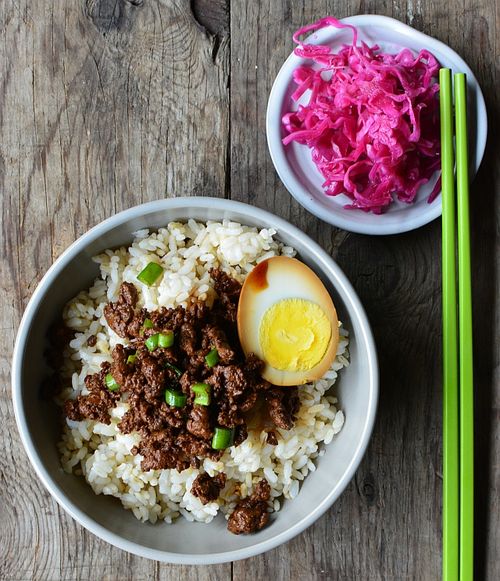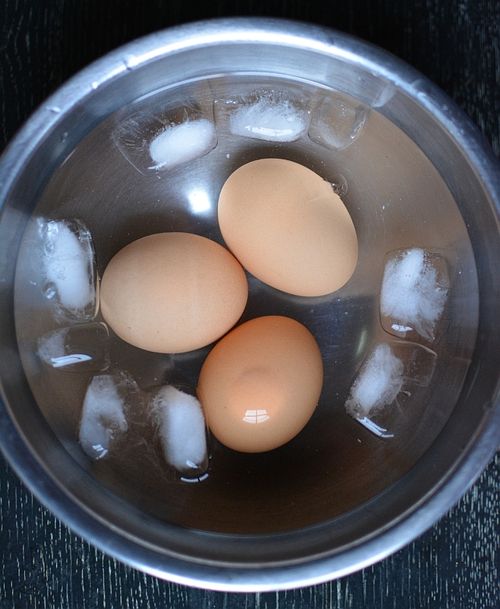Simple, savory and saucy. Those words sum up this recipe for a Taiwanese favorite. I first had this rustic comfort dish in Taipei in 2010, while doing field research for Asian Tofu. I was on a budget and after long day of chasing bean curd, I came across a locals only cafe that specialized in rustic rice dishes. The menu was small and you picked out little salads and ordered a rice bowl with protein. I selected a cucumber salad, pressed tofu salad and a pork rice bowl. What surprised me was the rich, salty-sweet nubs of pork that graced the rice bowl. It was so good, I could barely stop eating. The humble pork rice bowl was low-meat eating at its best.
I didn’t think about the Taiwanese pork and rice treat until earlier this year when I ate at Pine and Crane in Los Angeles. The casual cafe had a lovely version, heady with bits of pork belly, five spice and star anise. There was boiled egg and a pickle side to go with the rice. I was hooked and made several renditions when I got home.
My knowledge of Taiwan is limited but the short time that I spent there, as well as my Taiwanese friends, totally charm me. As a result of geography and history, Taiwan is a wondrous combination of China, Japan, and Southeast Asia. There’s sushi, Shanghai soup dumplings, and Thai basil on menus. Night markets happen daily in Taipei. The cab drivers are nice and knowledgeable. People are generous and outward looking.
That’s why I gravitated toward Cathy Erway’s new book, The Food of Taiwan. It’s a great travelogue and introduction to Taiwan, its culture, history, and cooking. Cathy does a nice job with making cultural equivalents so as to create bridges that help people better understand Taiwanese food.
For example, her recipe introduction (“headnote”) for this lu rou fan described it as “the standard Taiwanese standard Sunday sauce, or ragu.” You can serve it over rice or noodles. I made it last Sunday with the addition of star anise and boiled eggs, which I really enjoy in this preparation. For the shallot, I fried it as part of the recipe, which I usually do. Overall, it was easy and fun.
The flavors can seem very bold so use the lesser amount of soy sauce, if you like. Or, choose a Taiwanese soy sauce, like Kimlan brand, which tends to be sweeter and lighter in flavor than mainland Chinese soy sauce. I served the pork atop beige rice and on the side, citrusy red cabbage pickle (see The Banh Mi Handbook for the recipe) and stir-fried vegetable.
There are likely countless ways to make this Taiwanese comfort food so try this recipe out and make it your own! Use gluten-free soy sauce, if you like.
Recipe
Five Spice Pork Sauce
Yields: 4 servings
Ingredients
- 2 ounces (60 g) thinly sliced shallot
- 3 tablespoons canola or other neutral oil
- 1 garlic clove, minced
- 1 pound (450 g) ground pork or coarsely ground/hand-chopped pork shoulder or belly
- 1 ½ teaspoons sugar
- ½ teaspoon Chinese five-spice powder
- 1 star anise (8 robust points)
- ½ cup Shaoxing rice wine
- 2 cups water
- ⅓ to ½ cup regular soy sauce
- 3 to 4 tablespoons dark soy sauce, or 2 tablespoons regular soy plus 1 to 2 tablespoons dark molasses
- 3 or 4 medium or large eggs
- 2 green onions, green part only, cut into rings
Method
- To facilitate quicker frying, blot moisture from the shallot with paper towel. Set aside. Heat the oil in a medium pot over medium heat. Add the shallot and gently fry for about 5 minutes, stirring frequently and lowering the heat to control the browning process. When the shallot closes in on a rich brown, use a slotted spoon to transfer it to a paper towel to cool and crisp.
- Off heat, remove all but 1 tablespoon of oil; reserve the tasty oil for something else. Return the heat to medium, add the garlic and cook until fragrant, about 1 minute. Add the pork, pushing and mashing it to small pieces. When it’s no longer pinkish, add the sugar, five spice, star anise and fried shallot. Cook, stirring, until well blended, about 1 minute.
- Pour in the rice wine, adjust the heat to bring to a boil, then let things rapidly bubble for about 30 seconds. Stir, once in awhile. Add the water and regular and dark soy sauces. Lower the heat to medium-low or low, cover, and gently simmer for 1 good hour. Cathy says you can go as long as 2 hours to arrive at very tender pork and a slightly thickened sauce.
- Meanwhile bring the eggs to room temperature before boiling them. If you need an assist, see these hard-boiled egg tips for guidance. Peel the eggs after they’ve cooled and set aside.
- When the pork is done, add the eggs, return the pot to a simmer, then turn off the heat. Let sit, uncovered, for 15 minutes for flavors to develop. This dish can be refrigerate for up to several days. Reheat before serving.
- To serve, cut the eggs in half or quarters. Scoop the pork and some of the cooking liquid onto your bowl of rice add the egg and garnish with green onion.
Adapted from Cathy Erway's The Food of Taiwan (Houghton Mifflin, 2015).
Related post:





















Rhianna says
If I were to used packaged dried shallots instead of frying my own, would I still use 2 oz?
Andrea Nguyen says
No, you'd use a lot less. I venture about .25 to .5 ounce. You can't go wrong if you use too much, right?
Rhianna says
Nope—a convenience product that is delicious! Thank you for replying.